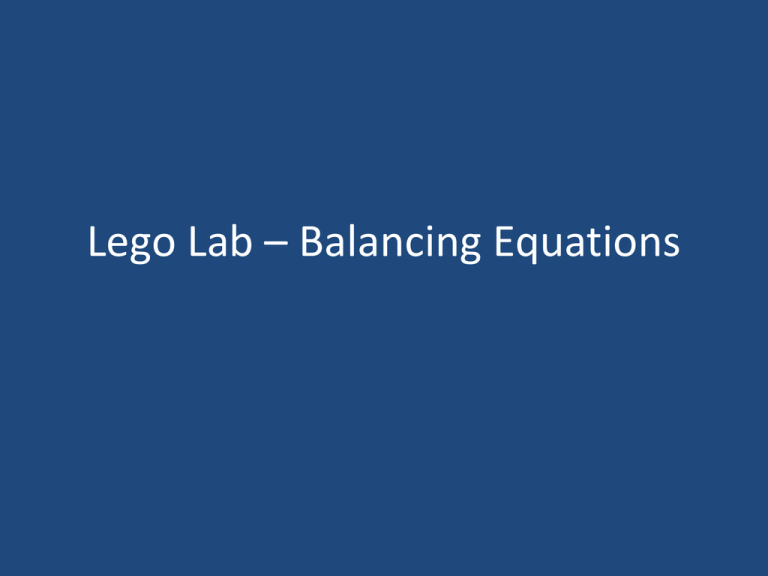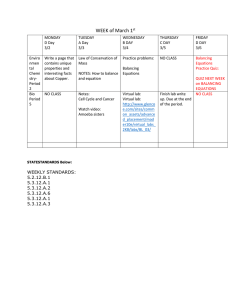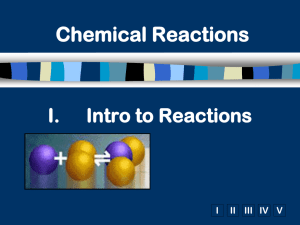state
advertisement

Lego Lab – Balancing Equations • Objective: – Today I will be able to: • Apply the law of conservation of matter to balancing chemical equations. • Evaluation/Assessment: – Informal Assessment – Listening to student interactions during the lego lab. – Formal Assessment – Analyzing student responses to the lego lab and the exit ticket • Common Core Connection – – – – Build Strong Content Knowledge Model with mathematics Make sense of problem and persevere in solving them Use appropriate tools strategically Lesson Sequence • Evaluate: Warm – Up • Explain: Balancing Chemical Equations Notes • Engage and Explore: Lego balancing equations lab • Evaluate: Exit Ticket Warm - Up • For the following reaction: – 2Na(s) + Cl2(g) 2NaCl(s) • • • • • Determine the reactants and products What state is the reactant chlorine in? What state is sodium chloride in? What is the coefficient for sodium? What is the subscript for chlorine? Warm - Up • Why do chemical equations need to be balanced? • Balance the following chemical equations – Fe + O2 → Fe2O3 Objective • Today I will be able to: – Apply the law of conservation of matter to balancing chemical equations. Homework • Complete the balancing equations practice Agenda • • • • • Warm – Up Collect Homework Balancing Chemical Equations Notes Lego Lab Exit Ticket Balancing Chemical Equations Think back! What is the Law of Conservation of Matter? • Matter can not be created or destroyed, it can be transformed from one form to another. Why is this important for chemical equations? • Same number of each element on the reactant side as the product side • Balanced Ms. Ose’s Tips for Balancing Equations • Must satisfy the law of conservation of matter • Only use whole number coefficients • All atoms should be present on both the reactant and product side of the equation • Check to see if the equation is already balanced • Coefficients go in front of the substance and multiply all subscripts Ms. Ose’s tips for balancing equations continued • One (1) is understood and does not have to be written as a coefficient • All coefficients should be reduced to lowest terms • Balance most complex species first and then move to single atoms • Double check your work! BaS + NaCl Na2S + BaCl2 Example 1 BaS + 2 NaCl Na2S + BaCl2 Answer P + O2 P 2 O5 Example 2 4P + 5O2 2P2O5 Answer Na2O2 + H2O NaOH+ O2 Example 3 You Try! 2Na2O2 + 2H2O 4NaOH + O2 Answer Balancing Equation Lab Lego Balancing Lab Directions • Get into groups • Travel to the stations and balance the equations using the legos • Each color represents a specific type of atom • You must complete 7/10 stations. You may pick which stations you complete • Watch Ms. Ose’s Demo • DO NOT THROW THE LEGOS Exit Ticket • Complete the lab mini - quiz


